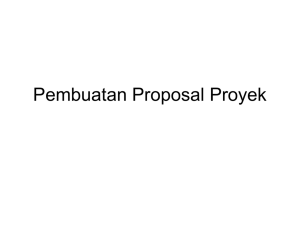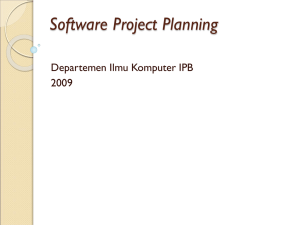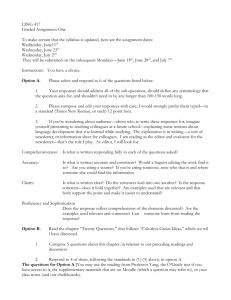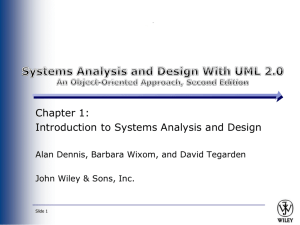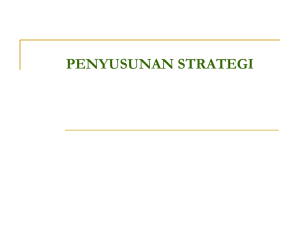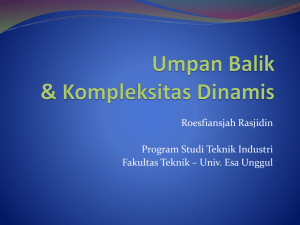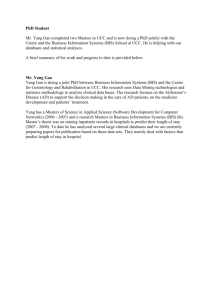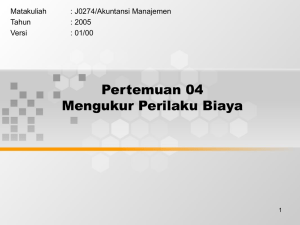Peyusunan Proposal Proyek
advertisement
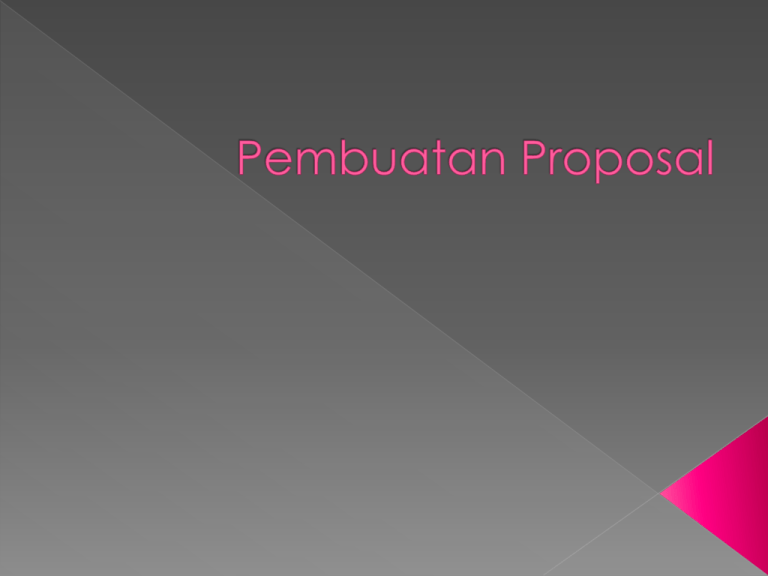
Failure to focus on the client's business problems and payoffs—the content sounds generic. No persuasive structure—the proposal is an "information dump." No clear differentiation of this vendor compared to others. Failure to offer a compelling value proposition. Key points are buried—no impact, no highlighting. Difficult to read because they're full of jargon, too long, or too technical. Credibility killers—misspellings, grammar and punctuation errors, use of the wrong client's name, inconsistent formats, and similar mistakes It's not a price quote. If all you tell the decision maker is the amount he or she has to pay, you've reduced what you're selling down to the level of a commodity. You've said, in effect, "All products or services of this type are basically the same. We have nothing unique to offer. Choose based on cost." Unless you are always the lowestpriced vendor, that's not a strong position to take. It's not a bill of materials, project plan, or scope of work. In technical and engineering environments, people sometimes take the attitude that if they just explain all the details of the proposed solution very clearly and accurately, the customer will buy. Actually, giving customers a detailed bill of materials or project plan may have exactly the opposite effect. You've just given them a shopping list so detailed they may decide to do the job without your help. Ouch! It's not the company history, either. Oddly enough, a sizable number of the proposals we see start out that way. Why? From reading dozens and dozens of these things, I can assure you most company histories are not very interesting. Here's the bottom line: What is a proposal? It's a sales document. Compare vendors, offers, or prices so he or she can make an informed decision Clarify complex information Make the buying process more "objective" Slow down the sales process Solicit creative ideas, become educated, or get free consulting The obvious: helping you sell. The proposal's most important job is to help you sell something. (In the nonprofit realm, it should help you obtain funding in support of your mission and objectives.) To go a little further, though, a high-quality, carefully constructed proposal can help you: › › › › › › Sell on value instead of price: Use your proposal to move the decision maker's focus away from price and toward such measures of value as lower total cost of ownership, higher reliability, direct customer support, documented technical superiority, or some other message that separates you from your competitors. Compete successfully without having personal contact with every member of the decision team: You may never have the opportunity to meet every member of the team in person. A good proposal can speak to each member of the team, helping make your case. Demonstrate your competence and professionalism: It's probably not fair and it's definitely not logical, but almost everybody does it: We judge a vendor's ability to deliver goods or services from the quality of the proposal they submit. Our conscious, rational mind tells us that spelling and grammar have nothing to do with the ability to provide help desk support for our PC users, yet we find those misspellings and grammar mistakes raising doubt and uncertainty in our mind. Offer a bundled solution: The customer may ask you for a proposal for basic bookkeeping services. In your proposal, though, you can add a brief description of your ability to provide tax preparation, too, as part of a total solution. That will increase the size of the deal, it may differentiate you from other bookkeepers who submit a proposal, or it may just make the customer aware that you also do taxes. All of these are good things. Sell the "smarter" buyer: Smart buyers want to gain as much as possible while spending as little as possible. If you don't show them what they gain by choosing your recommendations, they will inevitably focus on the other half of the equation: spending very little. Sell a complex, technical product to nontechnical buyers: Speaking the buyer's language is an important part of winning his or her trust. A flexible proposal process can help you communicate effectively even if the customer lacks in-depth knowledge of what you're offering. The proposal as a marketing tool. Think about your company's image. What do your clients think of you? What do prospects who have never worked with you assume about you? Influencing clients. Good account management requires you to think about the future of your business relationships, not merely the immediate opportunity. Reacting to a customer's problems or needs when the customer brings them up is all right, but it's not nearly as effective as working with the customer collaboratively to develop a business direction. “Penunjukan Langsung” oleh Client (pemberi kerja). Melalui Tender. Konsultan (tim pengembang) melakukan survei di perusahaan Client (wawancara, mengumpulkan dokumen, observasi sistem dan prosedur kerja). Konsultan menyusun proposal (bisa dengan berkonsultasi dengan Client). Negosiasi antara Konsultan dan Client. Penanda-tanganan dokumen kontrak oleh Konsultan dan Client. Singkat tapi jelas (minimal). Kisi-kisi materi disusun atas kesepakatan Client – Konsultan. Bisa hanya terdiri dari satu dokumen, isi utama: spesifikasi teknis sistem / PL yang akan dibangun, rencana kerja, anggaran yang diusulkan (atau hanya nilai total proyek yang diminta). Client menyusun TOR (KAK). Pengumuman lelang / tender proyek melalui media publikasi atau pengiriman undangan tender kpd Konsultan2 yang dipilih. Pendaftaran peserta tender (= Konsultan). Pemasukan proposal tender oleh peserta. Penilaian dan seleksi proposal pemenang. Pengumuman pemenang. Penanda-tanganan dok kontrak dan penerbitan SPK (Surat Perintah Kerja) oleh Client. Setelah membaca TOR/KAK: To BID or NOT bid (ikut tender / tidak)? Biaya yang dikeluarkan untuk penyusunan proposal (untuk gaji tim penyusun, survei awal, peralatan): ~ 10% dari nilai proyek. Waktu penyusunan proposal: dapat dipenuhi? Mampu melaksanakan TOR atau tidak? (Pertimbangan: keahlian personil yang ada, peralatan yang dimiliki Konsultan, waktu yang ditetapkan pada TOR.) Proposal Administrasi: Profil Perusahaan (struktur organisasi, manajemen, “kondisi keuangan”), pengalaman (proyek2 yg sdh dikerjakan). Proposal Teknis Proposal Biaya Penampilan menarik (perhatikan: cover, struktur isi buku, font, gambar berwarna). Jelas (disertai dg visualisasi – gambar, tabel, grafik). Isi meyakinkan: konsisten, “menjawab” semua butir-butir TOR dg baik. Keahlian tim pelaksana proyek dipresentasikan dengan meyakinkan (perhatikan: pendidikan, pengalaman). Bab 1: Pendahuluan (biasanya isi TOR). Bab 2: Tanggapan thd TOR Bab 3: Bahasan sistem (PL) yg diusulkan (dpt > 1 bab, jika perlu). Bab 4: Metodologi Pelaksanaan Pekerjaan. Bab 5: Kesimpulan. Lampiran: CV para tenaga ahli. Executive Summary: a short statement of your case and summary of the entire proposal; typically 1 to 2 pages. Statement of Need: why this project is necessary; 1 to 3 pages Project Description: nuts and bolts of how the project will be implemented; 2 to 5 pages Bid Amount/Budget: financial description of the project plus explanatory notes; 1 to 2 pages Organization Information: history and structure of the company; its primary activities, clientele, and services; 1 to 2 pages Conclusion: summary of the proposal's main points; one-page. The first page of the proposal is the most important section of the entire document. Here you will provide the reader with a snapshot of what is to follow. It summarizes all of the key information and is a sales document designed to convince the reader that this proposal should be considered. Be certain to include: Problem: A brief statement of the problem or need your company has recognized and is prepared to address (one or two paragraphs); Solution: A short description of the project, including what will take place and the benefits, how it will operate, how long it will take, and how it will be staffed (one or two paragraphs); The organization and its expertise: a brief statement of the name, history, purpose, and activities of your company, emphasizing its capacity to carry out this proposal (one paragraph). Write your proposal like a sales documents. The statement of need will enable the evaluator to learn more about the issues and to understand the problem that the project will remedy. It presents the facts and evidence that support the need for the project and establishes that your company understands the problems and therefore can reasonably address them. You want the need section to be logical, yet persuasive. Like a good debater, you must assemble all the arguments. Then present them in a logical sequence that will readily convince the reader of their importance. As you marshal your arguments, consider the following points. Demonstrate complete understanding of the stated requirement or problem. Be specific and direct, being vague only demonstrates that you do not understand the requirements and will create questions in the mind of the evaluator. Be sure the data you present are accurate. There is nothing more embarrassing than to find out your information is out of date or incorrect. Decide which facts or statistics best support the project and substantiate your promises with facts and details. Information that does not relate to the project you are presenting will cause the reader to question the entire proposal. Objectives are the measurable outcomes of the project. This section of your proposal should have four subsections: Objectives, Methods, Staffing/administration, and Evaluation. Together, objectives and methods will dictate your staffing and administrative requirements. Methods This means that you demonstrate your ability to solve or meet the challenge. The methods section describes the specific activities that will take place to achieve the objectives. It might be helpful to divide your discussion of methods into the following: what, how, when, and why. Your proposal should clearly communicate your ability to successfully perform the contract. Documentation of successful fulfillment of other contracts will help prove your point. How: This is the detailed description of what will occur from the time the project begins until it is completed. Your methods should match the previously stated objectives. When: The methods section should present the order and timing for the tasks. It might make sense to provide a timetable so that the reader does not have to map out the sequencing on their own. The timetable tells the reader "when" and provides another summary of the project that supports the rest of the methods section. Why: You may need to defend your chosen methods, especially if they are a new approach. Why will the planned work lead to the outcomes you anticipate? You can answer this question in a number of ways, including using the valuation of an expert and examples of another projects that worked. The methods section helps the reader to visualize the implementation of the project. It should convince the reader that your company knows what it is doing, thereby again establishing credibility. In describing the methods, you will have mentioned staffing for the project. You now need to devote a few sentences to discussing the number of staff, their qualifications, and specific assignments. Details about individual staff members involved in the project can be included either as part of this section or in the appendix, depending on the length and importance of this information How will you free up the time of an already fully deployed individual? As you prepare to assemble the pricing, go back through the proposal narrative and make a list of all personnel and contractors related to the operation of the project. Be sure that you list not only new costs to complete the project but also any ongoing expenses for items that will be allocated to the project. Verify or get the relevant costs from the person in your agency who is responsible for keeping the books. You may need to estimate the proportions of your company’s ongoing expenses that should be charged to the project and any new costs, such as salaries for project personnel not yet hired. Put the costs you have identified next to each item on your list. Your list of pricing items and the calculations you have done to arrive at a dollar figure for each item should be summarized on worksheets. You should keep these to remind yourself how the numbers were developed. These worksheets can be useful as you continue to develop the proposal and discuss it with the evaluator; they are also a valuable tool for monitoring the project once it is under way and for reporting after completion. Some proposals require you to provide adequate management and cost information. In this case, you need to demonstrate your ability to account for all of the costs involved in performing the contract. Every proposal should have a concluding paragraph or two. This is a good place to call attention to the future, after the project is completed. If appropriate, you should outline some of the follow-up activities that might be undertaken. This section is also the place to make a final appeal for your company’s consideration. Briefly summarize what your company wants to do and why it is important. Packaging Cover design Cover letter Spell check Gather appendix materials Prepare table of contents, section dividers, etc. Production Where and by whom will the document be produced? Thoroughly reviewed the RFP Prepared any questions concerning the RFP and submitted to the contracting officer Obtained and reviewed background documentation for the project Evaluated your company’s strengths and weaknesses Evaluated your company’s competition Developed a strategy to differentiate your company Prepared document in the appropriate format Included commitment letters from potential employees, suppliers and funding sources If appropriate, past performance references Purchased a sufficient number of packaging materials? Binder rings, tabs, notebooks, etc. Deliver on time. Label the original documents and required number of copies. Seal the original and copies in a package and label appropriately. If mailing, don’t forget to check delivery schedules. If hand carrying, provide a signature receipt for the delivery person. Sistem kini (prosedur bisnis). Prosedur bisnis usulan (dan usulan perubahan organisasi, jika perlu). Deskripsi Umum + arsitektur sistem usulan (termasuk modul-modul). Diag Use case + skenario. Rancangan antar-muka pengguna. Analisis/perancangan basisdata (ER). Penjelasan umum tentang bagaiman sistem akan dibangun (langkah2 RPL). WBS + work package. Diagram PERT / CPM. Jadwal Proyek (gant-chart) (termasuk survei, demo, penyusunan laporan). Penjadwalan Personil Penjadwalan Penggunaan Alat Deskripsi isi laporan2. Terapkan asas kehati-hatian yang tinggi (jangan sampai salah estimasi lalu Konsultan rugi). Tidak “over-priced” (supaya berpeluang menang). Konsisten dengan isi Proposal Teknis (perhatikan isinya yang akan menjadi “komponen biaya”). Ringkasan biaya gaji personil, alat, komunikasi, survei/perjalanan, dokumen/penggandaan materi, pelatihan, instalasi dan TOTAL. Rincian biaya untuk setiap pos pengeluaran di atas. Penyusunan Proposal Teknik dan Biaya untuk menjawab TOR yang sudah disusun Dikumpulkan 2 minggu lagi. Cover Table of Content Cover letter (ditujukan ke elisati h) Executive Summary Pendahuluan › Our Understanding (Statement of Need): pemahaman konsultan ttng permasalahan yang di-ceritakan di TOR Tanggapan (proposed solution) › Bahasan sistem…(detil) › › › Tahapan pengerjaan Scheduling WBS › Estimasi biaya proyek (personil: mandays) Metodologi Pelaksanaan (Implementasi+Project Management) Biaya Kesimpulan CV semua anggota dengan posisi: PM, …(Programmer, Analyst&Desainer, Network Engineer, QA, dst…)
